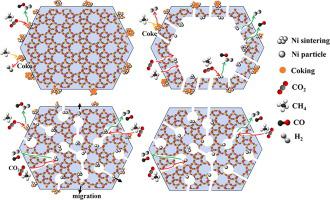Chemical Engineering Journal ( IF 13.3 ) Pub Date : 2022-06-08 , DOI: 10.1016/j.cej.2022.137439 Shanshan Xu , Thomas J.A. Slater , Hong Huang , Yangtao Zhou , Yilai Jiao , Christopher M.A. Parlett , Shaoliang Guan , Sarayute Chansai , Shaojun Xu , Xinrui Wang , Christopher Hardacre , Xiaolei Fan

|
The stability of catalysts in dry reforming of methane (DRM) is a known issue. In this paper an encapsulation strategy has been employed to improve the stability compared with conventional impregnation methods. Herein, nickel nanoparticles encapsulated in silicalite-1 were prepared using a range of methods including post treatment, direct hydrothermal and seed-directed methods to investigate the effect of synthesis protocol on the properties of catalysts, such as degree of encapsulation and Ni dispersion, and anti-coking/-sintering performance in DRM. The Ni@SiO2-S1 catalysts obtained by the seed-directed synthesis presented the full encapsulation of Ni NPs by the zeolite framework with small particle sizes (∼2.9 nm) and strong metal-support interaction, which could sterically hinder the migration/aggregation of Ni NPs and carbon deposition. Therefore, Ni@SiO2-S1 showed stable CO2/CH4 conversions of 80% and 73%, respectively, with negligible metal sintering and coking deposition (∼0.5 wt.%) over 28 h, which outperformed the other catalysts prepared. In contrast, the catalysts developed by the post-treatment and ethylenediamine-protected hydrothermal methods showed the co-existence of Ni phase on the internal and external surfaces, i.e. incomplete encapsulation, with large Ni particles, contributing to Ni sintering and coking. The correlation of the synthesis-structure-performance in this study sheds light on the design of coking-/sintering-resistant encapsulated catalysts for DRM.
中文翻译:

开发 Silicalite-1 封装的 Ni 纳米颗粒作为甲烷干重整的耐烧结/抗结焦催化剂
甲烷干重整 (DRM) 中催化剂的稳定性是一个已知问题。在本文中,与传统的浸渍方法相比,采用封装策略来提高稳定性。在此,使用一系列方法(包括后处理、直接水热法和种子导向法)制备了包封在硅质岩 1 中的镍纳米粒子,以研究合成方案对催化剂性能的影响,例如包封度和镍分散,以及DRM 中的抗焦化/烧结性能。Ni@SiO 2-通过种子定向合成获得的-S1催化剂将Ni NPs完全包裹在具有小粒径(~2.9 nm)和强金属-载体相互作用的沸石骨架中,这可能在空间上阻碍Ni NPs和碳的迁移/聚集沉积。因此,Ni@SiO 2 -S1 在 28 小时内表现出稳定的 CO 2 /CH 4转化率分别为 80% 和 73%,金属烧结和焦化沉积(~0.5 wt.%)可忽略不计,优于其他制备的催化剂。相比之下,后处理和乙二胺保护水热法开发的催化剂显示出Ni相在内外表面共存,即封装不完全,Ni颗粒大,有助于Ni烧结和结焦。本研究中合成-结构-性能的相关性为设计用于 DRM 的抗结焦/烧结包封催化剂提供了启示。











































 京公网安备 11010802027423号
京公网安备 11010802027423号